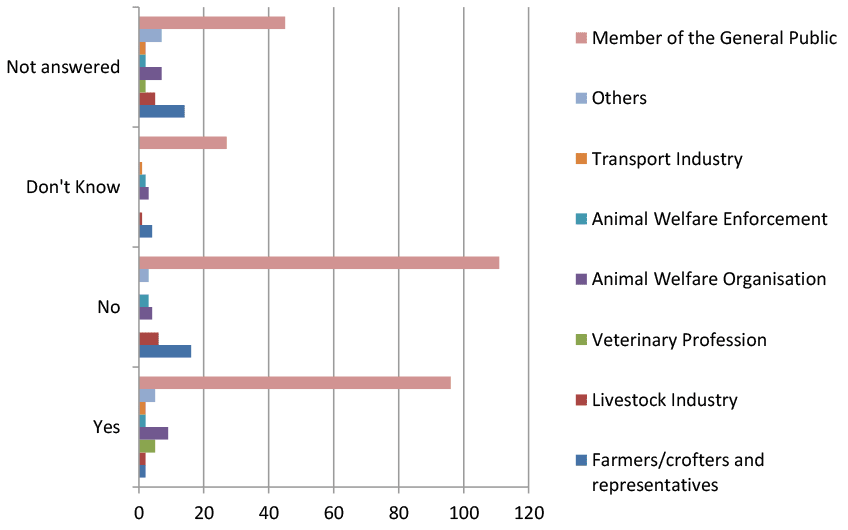Welfare of animals during transport - consultation: summary report
Analysis of the responses received to the full public consultation, between 4 December 2020 to 26 February 2021, of the Farm Animal Welfare Committee's opinion on the welfare of animals during transport.
Question 6
Do you agree with the Scottish Government’s position on the maximum time an animal may spend at market and proposed course of action? Please provide any further relevant information.
It is the view of the Scottish Government that the development of an improved evidence base, including relating to the latest science and best practice regarding loading, unloading and handling at markets should be supported. We also wish to consider how better to measure, monitor and record the total time spent at market, from initial unloading to final reloading.
Currently, the Welfare of Animals at Markets Order 1990 (as amended) sets down the animal welfare standards which apply to animals at markets, but these are not currently subject to a specific animal welfare licensing regime. We agree that a review of existing requirements applying to animals at market should be considered and that this could specifically set out the case for a new animal welfare licensing regime to be introduced for markets.
Given that animal welfare in transport regulations set maximum journey times, with additional requirements for rest periods, we agree with FAWC that we should also consider setting a maximum time an animal can spend at market.

Of the 304 responses to this question, 40.5 % were in favour of the Scottish Government’s position on the maximum time an animal may spend at market and proposed course of action. 47.0% were not in favour and 12.5% did not express a view.
Scotland’s Rural College, and others, suggested proper exploration of whether time spent at market “can constitute a rest period” and felt that opportunities for suitable rest might be available dependent on the facilities at individual markets e.g. island markets acting as collection points for onward transport. Highland Council also proposed that research could “be extended to look at livestock collection centres and gathering for sale of animals other than at a market”.
Animal welfare organisations generally considered that “times at market do not qualify as a rest period if eating/drinking/resting is not possible”. Where those conditions did not apply it was suggested that time spent at market “should be included in the journey time” (Four Paws UK). The British Veterinary Association agreed that position while also commenting that “in terms of biosecurity and disease control” the risk of disease spread would be increased by the length of time at market.
The Scottish SPCA also considered that “greater research regarding loading, unloading and handling at markets” could help. That suggestion was supported by a number of respondents who considered these actions to be stressors for the animals which may suggest that markets might not be a place of rest.
A number of organisations and individuals agreed to animal welfare licensing for markets and that this could cover “prevention of: poor handling, unfit animals being sold or transported, and poor conditions” for a stay at market (Abattoir Sector Group).
Respondents from the farming, transport, livestock, and enforcement sectors provided information on the current requirements and official controls at markets with some of these respondents suggesting that a licensing scheme may be unnecessary. While unlicensed, markets are “governed by the Welfare of Markets Order 1990” and officials from local authorities and the Animal and Plant Health Agency (APHA) “are regularly in attendance at markets” (NFU Scotland). It was also commented that “currently all markets are inspected annually by APHA vets and LA staff” allowing “improvements and issues to be addressed and rectified” (Scottish Animal Health & Welfare Panel).
In addition, these respondents informed that Scottish markets operate under the ‘Guidance on Best Practice for Livestock Markets in Scotland 2014’ which was described as a “61 point risk assessed control document and policy prepared in conjunction with Scottish Government, APHA and … local authorities” (Institute of Auctioneers and Appraisers in Scotland).
One respondent declined to comment on the proposal for maximum time at market as these had not been publicised. That respondent proposed that there could be a “minimum time animals should spend at market”(unnamed organisation) during which animals could be properly rested.
Contact
There is a problem
Thanks for your feedback